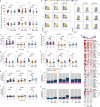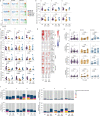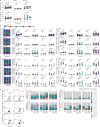Immune dynamics in SARS-CoV-2 experienced immunosuppressed rheumatoid arthritis or multiple sclerosis patients vaccinated with mRNA-1273
- PMID: 35838348
- PMCID: PMC9337853
- DOI: 10.7554/eLife.77969
Immune dynamics in SARS-CoV-2 experienced immunosuppressed rheumatoid arthritis or multiple sclerosis patients vaccinated with mRNA-1273
Abstract
Background: Patients affected by different types of autoimmune diseases, including common conditions such as multiple sclerosis (MS) and rheumatoid arthritis (RA), are often treated with immunosuppressants to suppress disease activity. It is not fully understood how the severe acute respiratory syndrome coronavirus 2 (SARS-CoV-2)-specific humoral and cellular immunity induced by infection and/or upon vaccination is affected by immunosuppressants.
Methods: The dynamics of cellular immune reactivation upon vaccination of SARS-CoV-2 experienced MS patients treated with the humanized anti-CD20 monoclonal antibody ocrelizumab (OCR) and RA patients treated with methotrexate (MTX) monotherapy were analyzed at great depth via high-dimensional flow cytometry of whole blood samples upon vaccination with the SARS-CoV-2 mRNA-1273 (Moderna) vaccine. Longitudinal B and T cell immune responses were compared to SARS-CoV-2 experienced healthy controls (HCs) before and 7 days after the first and second vaccination.
Results: OCR-treated MS patients exhibit a preserved recall response of CD8+ T central memory cells following first vaccination compared to HCs and a similar CD4+ circulating T follicular helper 1 and T helper 1 dynamics, whereas humoral and B cell responses were strongly impaired resulting in absence of SARS-CoV-2-specific humoral immunity. MTX treatment significantly delayed antibody levels and B reactivation following the first vaccination, including sustained inhibition of overall reactivation marker dynamics of the responding CD4+ and CD8+ T cells.
Conclusions: Together, these findings indicate that SARS-CoV-2 experienced MS-OCR patients may still benefit from vaccination by inducing a broad CD8+ T cell response which has been associated with milder disease outcome. The delayed vaccine-induced IgG kinetics in RA-MTX patients indicate an increased risk after the first vaccination, which might require additional shielding or alternative strategies such as treatment interruptions in vulnerable patients.
Funding: This research project was supported by ZonMw (The Netherlands Organization for Health Research and Development, #10430072010007), the European Union's Horizon 2020 research and innovation program under the Marie Skłodowska-Curie grant agreement (#792532 and #860003), the European Commission (SUPPORT-E, #101015756) and by PPOC (#20_21 L2506), the NHMRC Leadership Investigator Grant (#1173871).
Keywords: COVID-19 mRNA vaccine; SARS-CoV-2; autoimmune disease; human; immunity; immunology; immunosuppressant; inflammation; medicine; multiple sclerosis; rheumatoid arthritis.
© 2022, Verstegen et al.
Conflict of interest statement
NV, RH, Jv, LK, CK, TA, LK, MS, MD, Rd, Nd, Cv, AB, EM, KK, Kv, ES, LB, GW, ST, Zv, LW, TK, FE, TR, Sv, At, Cv No competing interests declared, JK has speaking relationships with Merck, Biogen, TEVA, Sanofi, Genzyme, Roche and Novartis. AmsterdamUMC, location VUmc, MS Center Amsterdam has received financial support for research activities from Merck, Celgene, Biogen, GlaxoSmithKline, Immunic, Roche, Teva, Sanofi, Genzyme, and Novartis
Figures












References
-
- Alison Tarke A, Coelho CH, Zhang Z, Dan JM, Yu ED, Methot N, Bloom NI, Goodwin B, Phillips E, Mallal S, Sidney J, Filaci G, Weiskopf D, da Silva Antunes R, Crotty S, Grifoni A, Sette A. SARS-CoV-2 Vaccination Induces Immunological Memory Able to Cross-Recognize Variants from Alpha to Omicron. bioRxiv. 2021 doi: 10.1101/2021.12.28.474333. - DOI - PMC - PubMed
-
- Apostolidis SA, Kakara M, Painter MM, Goel RR, Mathew D, Lenzi K, Rezk A, Patterson KR, Espinoza DA, Kadri JC, Markowitz DM, E Markowitz C, Mexhitaj I, Jacobs D, Babb A, Betts MR, Prak ETL, Weiskopf D, Grifoni A, Lundgreen KA, Gouma S, Sette A, Bates P, Hensley SE, Greenplate AR, Wherry EJ, Li R, Bar-Or A. Cellular and humoral immune responses following SARS-CoV-2 mRNA vaccination in patients with multiple sclerosis on anti-CD20 therapy. Nature Medicine. 2021;27:1990–2001. doi: 10.1038/s41591-021-01507-2. - DOI - PMC - PubMed
-
- Baden LR, El Sahly HM, Essink B, Kotloff K, Frey S, Novak R, Diemert D, Spector SA, Rouphael N, Creech CB, McGettigan J, Khetan S, Segall N, Solis J, Brosz A, Fierro C, Schwartz H, Neuzil K, Corey L, Gilbert P, Janes H, Follmann D, Marovich M, Mascola J, Polakowski L, Ledgerwood J, Graham BS, Bennett H, Pajon R, Knightly C, Leav B, Deng W, Zhou H, Han S, Ivarsson M, Miller J, Zaks T, COVE Study Group Efficacy and Safety of the mRNA-1273 SARS-CoV-2 Vaccine. The New England Journal of Medicine. 2021;384:403–416. doi: 10.1056/NEJMoa2035389. - DOI - PMC - PubMed
Publication types
MeSH terms
Substances
Associated data
LinkOut - more resources
Full Text Sources
Medical
Research Materials
Miscellaneous

